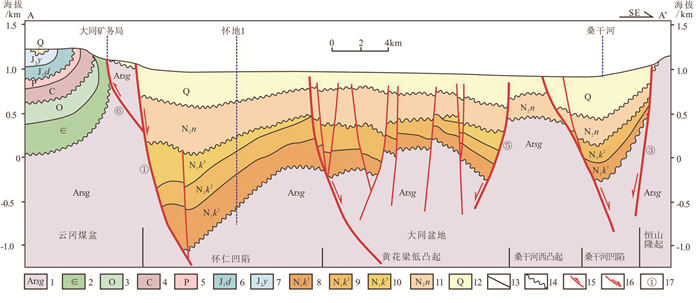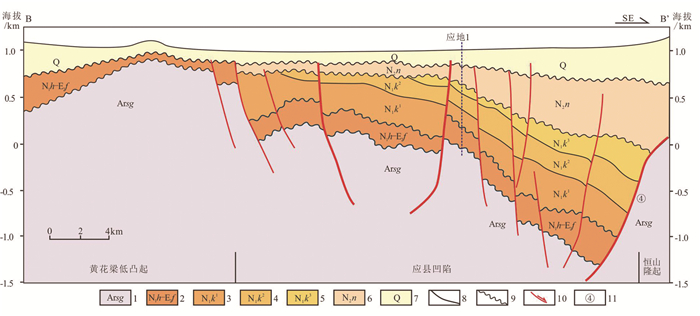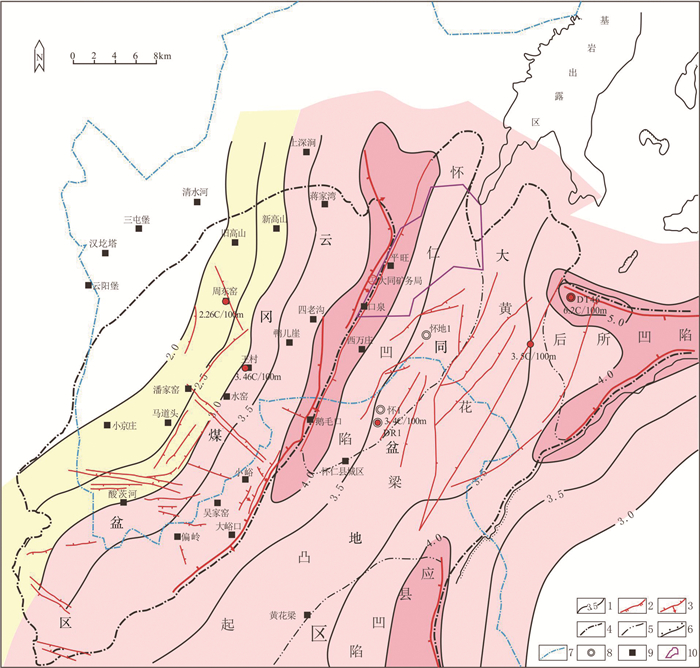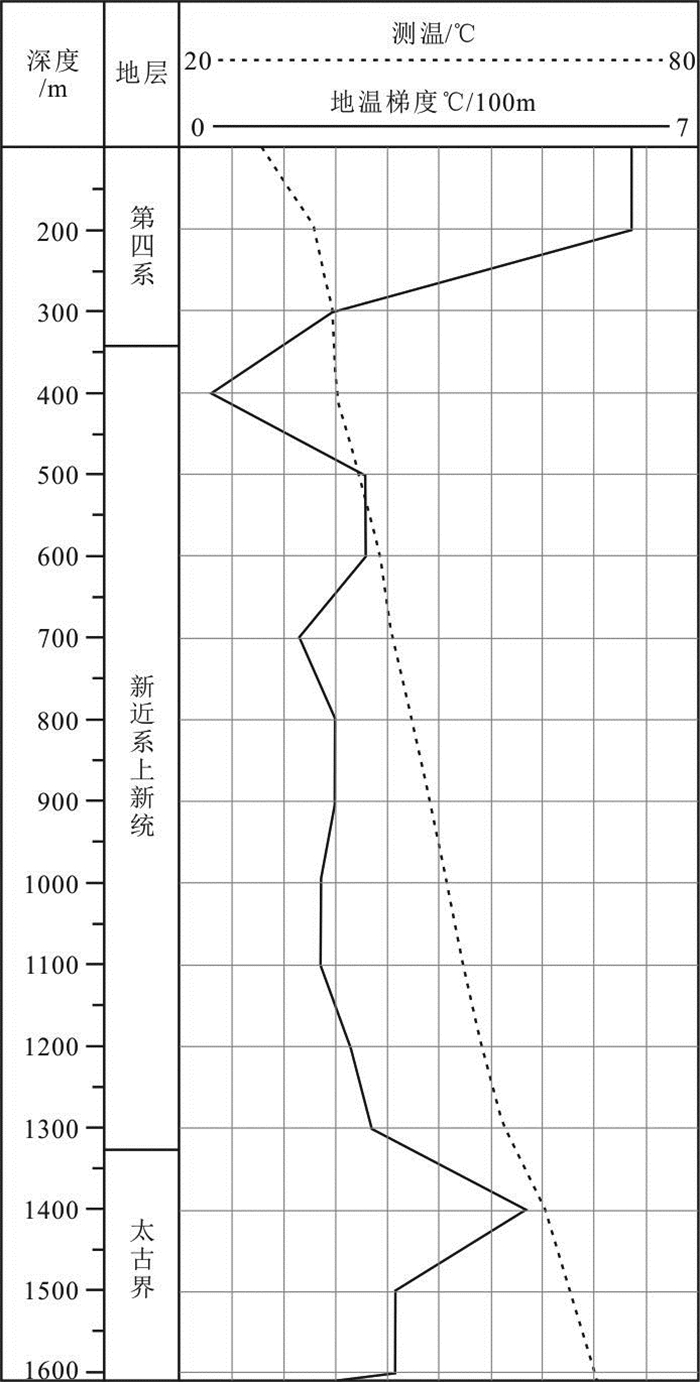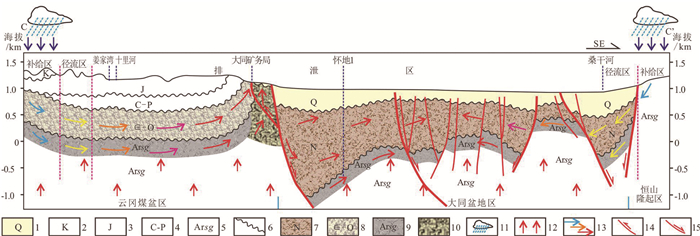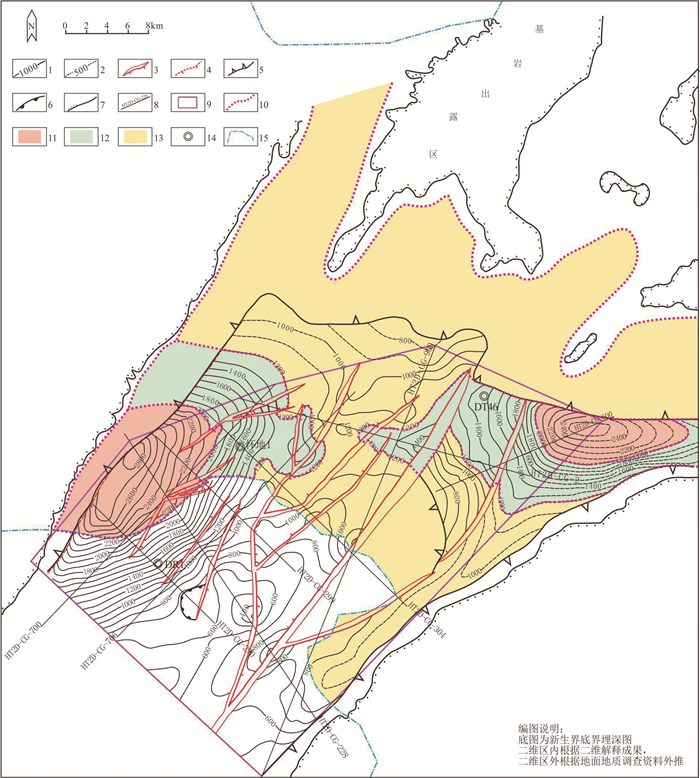Geothermal geological characteristics and resource potential in the north of Datong Basin, Shanxi Province
-
摘要:
研究目的 大同盆地为新生代断陷盆地,具有较优越的地热地质条件,但由于盆内地球物理和钻探资料较少,针对盆地结构、沉积地层分布、地热地质特征和资源评价研究相对薄弱,在一定程度上制约了对大同盆地地热资源的潜力认识和开发利用。
研究方法 本文综合应用新的二维地震及钻测井等油气和地热勘探资料,开展了大同盆地北部地质结构、断裂、沉积地层、地热地质特征等研究,评价了地热资源潜力,估算了地热资源量,指出了地热资源有利区。
研究结果 将大同盆地划分为怀仁凹陷、桑干河凹陷、应县凹陷和黄花梁低凸起、桑干河西凸起5个二级构造单元;盆地北部(大同市境内)具有较好的地热地质条件及地热资源潜力,主要发育新近系砂岩和太古界基岩两套热储层,并发育较厚的第四纪热盖层,新生代拉张作用和火山活动强烈,总体处于大地热流高值区,具备新近系砂岩和太古界基岩层状地热资源潜力,总静态资源量约68.8×1015 kJ,折合标煤约23.47亿t。
结论 综合评价认为大同盆地怀仁凹陷西部和桑干河凹陷北部为水热型地热资源一类区,是地热勘探开发有利目标区,热储埋深大于2000 m,预测平均水温大于60℃,单井涌水量可达60 m3/h,怀仁凹陷东北部和桑干河凹陷西南部为地热资源二类区,黄花梁低凸起和桑干河西凸起区地热资源相对较差。
Abstract:This paper is the result of geothermal survey engineering.
Objective The Datong Basin is a Cenozoic rifted basin with superior geothermal geological conditions. But due to the scarcity of geophysical and drilling data in the basin, the research on the basin structure, sedimentary stratigraphy distribution, geothermal geological characteristics and resource evaluation is relatively weak, which partly restricts the understanding of the potential of the geothermal resources of the Datong Basin, as well as the exploitation and utilization of the geothermal resources.
Methods In this paper, the new 2D seismic, regional geological survey, drilling and logging wells and other oil and gas and exploration data are comprehensively applied to carry out the research on the geological structure, fracture, sedimentary stratigraphy, and geothermal geological characteristics of the northern Datong Basin, and then evaluated the potential of geothermal resources, estimated the amount of geothermal resources, and pointed out the favorable zones of geothermal resources.
Results The Datong Basin is divided into five tectonic units: the Huairen sag, the Sanganhe sag, the Yingxian sag, the Huanghualiang low uplift and the Sanganhe low uplift. The northern part of the basin (within Datong City) is characterized by good geothermal geological conditions and resource potentials, with the development of two sets of thermal reservoirs: Neocene sandstone and Basement rock, and a thick Quaternary thermal cover, and the Cenozoic is characterized by strong tensional and volcanic activities, and is generally at the high value of geothermal heat flow. The area is in the high value of geothermal flow, and has the potential of geothermal resources of Neocene sandstone and Basement rock, with a total static resource of about 68.8×1015 kJ, which is equivalent to about 2.347 billion tons of standard coal.
Conclusions The comprehensive evaluation concludes that the western part of Huairen sag and the northern part of Sangganhe sag in Datong Basin are hydrothermal geothermal resource first-class areas, which are favorable target areas for geothermal exploration and development, with the buried depth of thermal reservoir more than 2000 m, the predicted average water temperature greater than 60℃, and the inflow volume of a single well up to 60 m3/h. The northeastern part of Huairen sag and the southwestern part of Sangganhe sag are geothermal resource second-class areas. The geothermal resources of Huanghualiang low uplift and Sangganhe low uplift area are relatively poor.
-

-
图 2 大同盆地北西-南东向地质结构剖面图(剖面位置、断层编号及名称见图 1)
Figure 2.
图 3 大同盆地过应县凹陷北西-南东向地震地质解释剖面(剖面位置、断层编号及名称见图 1)
Figure 3.
图 6 大同市北部地热系统成因模式图(剖面位置见图 1)
Figure 6.
表 1 大同盆地构造单元划分表
Table 1. Division of structural units in the Datong Basin

表 2 大同盆地怀仁凹陷怀地1井砂岩热储厚度统计
Table 2. Statistics of sandstone thermal storage thickness in Well Huaidi 1, Huairen Sag, Datong Basin

表 3 大同盆地怀仁凹陷怀地1井砂岩热储物性统计
Table 3. Statistics of thermal storage properties of sandstone in Well Huaidi 1, Huairen Sag, Datong Basin

表 4 大同盆地北部(大同市内)地热资源量估算参数
Table 4. Estimated parameters of geothermal resources in the northern part of Datong Basin, Datong City

表 5 大同市大同盆地区地热资源有利区评价标准
Table 5. Evaluation criteria of favorable geothermal resources in Datong Basin, Datong City

-
Cen Min, Dong Shuwen, Shi Wei, Zhou Taofa, Chen Long, Chen Xingqiang. 2015. Structural analysis on the formation mechanism of Datong Basin[J]. Geological Review, 61(6): 1235-1247(in Chinese with English abstract).
Chen Yi, Du Zhili, Sun Xiangcan, Wen Lei, Liu Yulong. 2021. Paleogene palynological assemblage in Huairen Depression, Datong Basin and its significance[J]. Geological Review, 67(Supp. 1): 54-56(in Chinese).
Duan Ruitao, Fang Zhongjing. 1995. Neotectonic characterlstics of the northern piedmont fault of the Liuling Mountain[J]. Seismology and Geology, 17(3): 207-213(in Chinese).
Han Yachao. 2013. Mesozonic Thrust Deformation on the Western Margin of the Datong Basin and Its Implications[D]. Beijing: China University of Geosciences (Beijing), 11-39(in Chinese with English abstract).
Han Ying, Bai Xuefeng, Zhang Xin. 2018. Discussion on geothermal resources and its exploitation and utilization model in Shanxi Province[J]. Geological Survey of China, 5(5): 13-20(in Chinese with English abstract).
He Xiuquan, Chen Jianfeng. 1998. A Study of Geothermal Resources of Shanxi[J]. Journal Geology & Mineral Resources North China, 13(2): 196-201(in Chinese with English abstract).
Jin Guilu. 1996. The formative causes of Majuanxiang geothermal field in Tianzhen county[J]. Journal of Xi'an College of Geology, 18(2): 43-49(in Chinese with English abstract).
Jin Wenjun. 2020. Hydrocarbon Accumulation Law and Favorable Target Prediction in the Datong Basin[D]. Beijing: China University of Geosciences (Beijing), 1-69(in Chinese with English abstract).
Li Shujing, Lü Guxian. 2021. "S"-type rotation and pull-apart tectonics of the Fen-Wei Graben[J]. Geoscience, 35(5): 1260-1266(in Chinese with English abstract).
Lin Wenjing, Liu Zhiming, Wang Wanli, Wang Guiling. 2013. The assessment of geothermal resources potential of China[J]. Geology in China, 40(1): 312-321(in Chinese with English abstract).
Liu Airong, Xu Yongjing, Liu Chenglin, Pang Ercheng. 2021. Geological characteristics and tectonic evolution of Datong Basin[J]. Geoscience, 35(5): 1296-1310(in Chinese with English abstract).
Liu Dongna. 2015. The Coupling Relationship of Coal Metamorphism and Sedimentary-Tectonic Magmatic Activity for Datong Double Period Coal-bearing Basin[D]. Taiyuan: Taiyuan University of Technology, 1-110(in Chinese with English abstract).
Ma Bing, Jia Lingxiao, Yu Yang, Wang Huan, Chen Jing, Zhong Shuai, Zhu Jichang. 2021. Geoscience and carbon neutralization: Current status and development direction[J]. Geology in China, 48(2): 347-358(in Chinese with English abstract).
Ma Jinlong, Xu Yigang. 2004. Petrology and geochemistry of the Cenozoic basalts from Yangyuan of Hebei Province and Datong of Shanxi Province: Implications for the deep process in the western North China Craton[J]. Geochimica, 33(1): 75-88(in Chinese with English abstract). doi: 10.3321/j.issn:0379-1726.2004.01.010
Qi Lang, Liu Wei, Liu Xuan, Liu Ruichun, Wang Shuaijun. 2012. The fault characteristics study of Kouquan village section of Kouquan Fault[J]. North China Earthquake Sciences, 30(1): 44-47(in Chinese with English abstract).
Qu Wei, Wang Qingliang, Zhang Qin1, Peng Jianbing, Zhang Ming. 2013. Present crustal deformation and strain charcteristics of Datong Basin[J]. Journal of Geodesy and Geodynamics, 33(3): 12-15(in Chinese with English abstract).
Shi Qilei. 2019, Tectonic Thermal Evolution Characteristics of the Datong Basin[D]. Beijing: China University of Geosciences (Beijing), 1-58(in Chinese with English abstract).
Shanxi Provincial Bureau of Geology and Mineral Resources. 1989. Regional Geology of Shanxi Province[M]. Beijing: Geological Publishing House(in Chinese).
Song Meiqin, Zhang Shuliang, Liang Xiangjun, Wang Xiuwen, Jin Yuzhen, Tang Laili, Yang Shiying. 2008. Variation characteristics of regional stress field in Datong basin and its relationship with medium strong earthquakes[J]. Earthquake Research in Shanxi, (3): 1-5(in Chinese with English abstract).
Song Ru, Jing Zhenquan, Wang Feiyue. 2004. Analysis of geothermal-controlling phenomenon and the mechanism of ground fissure in Fen-Weihe down-faulted basin belt[J]. Coal Geology of China, 16(2): 26-33.
Wang Chen. 2015, The Research on The Characteristics of Crustal Deformation in Fenwei Rift Zone[D]. Xi'an: Xi'an University of Science and Technology, 7-44(in Chinese with English abstract).
Xie Xinsheng, Jiang Huali, Wang Rui, Wang Huanzhen, Feng Xiying. 2003. Holocene Paleo-seismic activities on the Kouquan fault zone, Datong Basin, Shanxi Province[J]. Seismology and Geology, 25(3): 359-374(in Chinese with English abstract).
Xing Zuoyun, Zhao Bin, Tu Meiyi, Xing Jishan. 2005. The formation of the Fenwei rift valley[J]. Earth Science Frontiers, 12(2): 247-262(in Chinese with English abstract).
Xu Wei, Liu Xudong, Zhang Shimin. 2011. Research of recent Late Quaternary activity in the middle part of Kouquan fault [J]. Earthquake Research in China, 27(4): 386-395(in Chinese with English abstract).
Xu Yunlong. 2015. The Study on the Formation and Evolution of Datong Cenozoie Down-Faulted Basin[D]. Taiyuan: Taiyuan University of Technology, 33-73(in Chinese with English abstract).
Yang Xiaoxin, Chen Shenjun, Yi Zhigang, Lü Yuejun, Zhao Jingmei. 1992. A study on the geothermal anomaly and of the Datong-Yanggao earthquake[J]. Northwestern Seismological Journal, 14 (1): 23-28(in Chinese with English abstract).
Zhai Jiao, Hu Xiaomeng, Wang Lili, Lu Hailong. 2011. Summary of the research on volcano eruptions in Datong Basin[J]. Journal of Institute of Disaster-Prevention Science and Technology, 13(1): 82-86(in Chinese with English abstract).
Zhang Yuliang. 2019. Analysis of geothermal geological conditions in the area of Liudongying of Huairen sag In Datong Basin[J]. Underground Water, 41(5): 15-17(in Chinese with English abstract).
Zheng Xiuqing, Li Yiming, Chen Zhong, Jin Guilu, Dong Zhongyi. 2000. Majuanxiang underground thermal water system in Yanggao-tianzhen Basin[J]. Journal of Taiyuan University of Technology, 31(1): 68-71(in Chinese with English abstract).
Zhou Zongying, Liu Shiliang, Liu Jinxia. 2015. Study on the characteristics and development strategies of geothermal resources in China[J]. Journal of Natural Resources, 30(7): 1210-1221(in Chinese with English abstract).
岑敏, 董树文, 施炜, 周涛发, 陈龙, 陈兴强. 2015. 大同盆地形成机制的构造研究[J]. 地质论评, 61(6): 1235-1247.
陈夷, 杜治利, 孙相灿, 文磊, 刘玉龙. 2021. 大同盆地怀仁凹陷古近系孢粉组合及其意义[J]. 地质论评, 67(增刊1): 54-56.
段瑞涛, 方仲景. 1995. 六棱山北麓断裂新活动特征[J]. 地震地质, 17(3): 207-213.
韩亚超. 2013. 大同盆地西缘中生代逆冲构造变形[D]. 北京: 中国地质大学(北京), 11-39.
韩颖, 白雪峰, 张欣. 2018. 山西省地热资源及其开发利用模式探讨[J]. 中国地质调查, 5(5): 13-20.
贺秀全, 陈建锋. 1998. 山西省地热资源研究[J]. 华北地质矿产杂志, 13(2): 196-201.
靳贵禄. 1996. 天镇县马圈庠地热田成因[J]. 西安地质学院学报, 18(2): 43-49.
金文君. 2020. 大同盆地油气成藏规律与有利目标预测[D]. 北京: 中国地质大学(北京), 1-69.
李述靖, 吕古贤. 2021. 试论汾渭"S"型旋转拉分构造体系及其影响[J]. 现代地质, 35(5): 1260-1266.
蔺文静, 刘志明, 王婉丽, 王贵玲. 2013. 中国地热资源及其潜力评估[J]. 中国地质, 40(1): 312-321. http://geochina.cgs.gov.cn/cn/article/id/20130121
刘爱荣, 徐永婧, 刘成林, 庞尔成. 2021. 大同盆地地质特征及构造演化研究[J]. 现代地质, 35(5): 1296-1310.
刘东娜. 2015. 大同双纪含煤盆地煤变质作用与沉积-构造岩浆活动的耦合关系[D]. 太原: 太原理工大学, 1-110.
马冰, 贾凌霄, 于洋, 王欢, 陈静, 钟帅, 朱吉昌. 2021. 地球科学与碳中和: 现状与发展方向[J]. 中国地质, 48(2): 347-358. http://geochina.cgs.gov.cn/cn/article/doi/10.12029/gc20210201
马金龙, 徐义刚. 2004. 河北阳原和山西大同新生代玄武岩的岩石地球化学将征: 华北克拉通西部深部地质过程初探[J]. 地球化学, 33(1): 75-88.
齐浪, 刘巍, 刘轩, 刘瑞春, 王帅军. 2012. 口泉断裂口泉村段断裂特征研究[J]. 华北地震科学, 30(1): 44-47.
瞿伟, 王庆良, 张勤, 彭建兵, 张明. 2013. 大同盆地现今地壳形变及应变分布特征[J]. 大地测量与地球动力学, 33(3): 11-15.
史启磊. 2019. 大同盆地构造热演化特征研究[D]. 北京: 中国地质大学(北京), 1-58.
山西省地质矿产局. 1989. 山西省区域地质志[M]. 北京: 地质出版社.
宋美琴, 张淑亮, 梁向军, 王秀文, 靳玉贞, 唐垒黎, 杨世英. 2008. 大同盆地区域应力场变化特征及其与中强地震的关系[J]. 山西地震, (3): 1-5.
宋儒, 姜振泉, 王飞跃. 2004. 汾渭地堑地裂缝的控热现象及其机制分析[J]. 中国煤田地质, 16(2): 26-33.
王晨. 2015. 汾渭断裂带地壳形变特征分析[D]. 西安: 西安科技大学, 7-44.
谢新生, 江娃利, 王瑞, 王焕贞, 冯西英. 2003. 山西大同盆地口泉断裂全新世古地震活动[J]. 地震地质, 25(3): 359-2374.
邢作云, 赵斌, 涂美义, 邢集善. 2005. 汾渭裂谷系与造山带耦合关系及其形成机制研究[J]. 地学前缘, 12(2): 247-262.
徐伟, 刘旭东, 张世民. 2011. 口泉断裂中段晚第四纪最新活动研究[J]. 中国地震, 27(4): 386-395.
许云龙. 2015. 大同新生代断陷盆地形成与演化[D]. 太原: 太原理工大学, 33-73.
杨修信, 陈沉俊, 易志刚, 吕悦军, 赵京梅. 1992. 大同-阳高地震地热异常与机理初探[J]. 西北地震学报, 14(1): 23-28.
翟姣, 胡小猛, 王丽丽, 卢海龙. 2011. 大同盆地火山活动研究综述[J]. 防灾科技学院学报, 13(1): 82-86.
张玉良. 2019. 大同盆地怀仁凹陷柳东营一带地热地质条件分析[J]. 地下水, 41(5): 15-17.
郑秀清, 李义明, 陈忠靳贵禄, 董忠义. 2000. 阳高-天镇盆地马圈庠地下热水系统[J]. 太原理工大学学报, 31(1): 68-71.
周总瑛, 刘世良, 刘金侠. 2015. 中国地热资源特点与发展对策[J]. 自然资源学报, 30(7): 1210-1221.
-



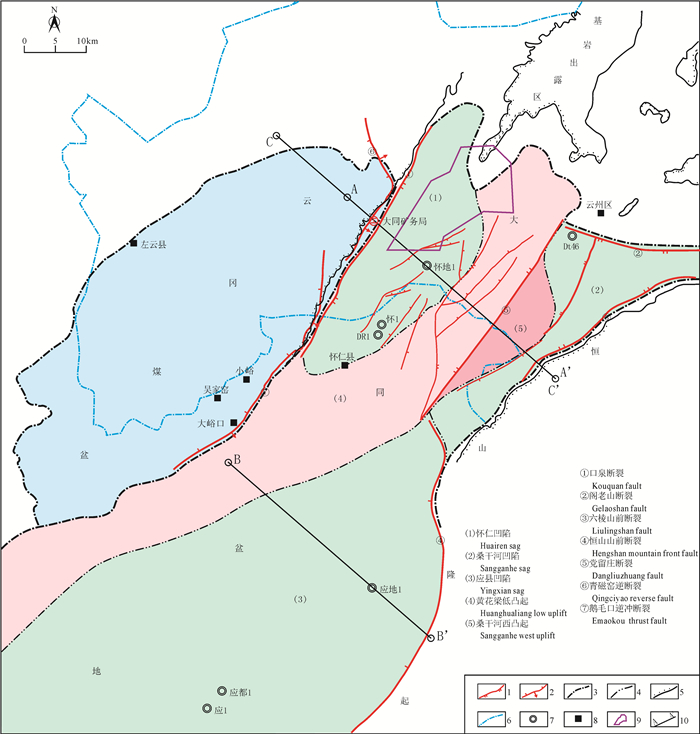
 下载:
下载:
